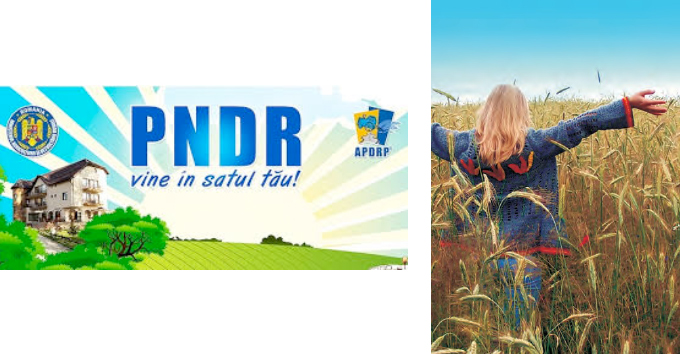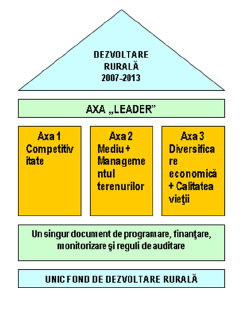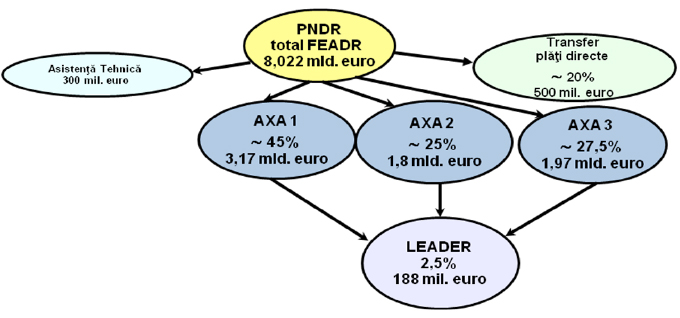National Rural Development Programme 2007 – 2013
27th September, 2013
Contributor: Vaslui
Funding sources for the development of sustainable food production in areas around Vaslui
National Rural Development Programme 2007-2013 (RDP) is the program that gives non reimbursable funds to private and public investment for development of villages in Romania, funds from the EU budget (EUR 8 billion) and national budget (2 billion euro).
Context
National Rural Development Programme, aims a series of objectives that support the competitiveness of the agri-food and forestry sectors, improve the environment and rural areas, improve the quality of life in rural areas, diversification of the rural economy, starting and operation of local development initiatives
RDP takes into account the need to protect nature, the environment, natural resources, land and water in rural areas, and improving quality of life for residents of rural areas, with positive implications for the whole economy.
Priority Axes:
Financial Allocation:
Results
The overall results, expected, of the RDP are:
- A more competitive agricultural sector, knowledge-based, that uses new technologies and focus on emerging markets;
- a more competitive agri-food sector, focusing on added value and innovative products for the domestic and foreign market;
- environmental friendly agriculture;
- diversification of agricultural activities to provide products and services for residents and tourists;
- creating new businesses based on rural, that respond to new markets;
- improved services and rural infrastructure to support the economy
RDP quantified results are:
- 200 000 participants at vocational training programs, information and diffusion of knowledge in order to improving and sustaining knowledge of managerial and technical skills in agriculture, forestry and agro-food
- 14,000 young farmers installed in rural areas and 400 million euros as an agreement for them to invest
- 95 000 farms supported by investments (EUR 2.2 billion), leading to their modernization (introduction and development of new technologies and procedures, diversification, adjusting the profile, level and quality of production to market requirements, including the organic one, as well as production and use of energy from renewable sources)
- 1050 forestry holdings to which it is regenerated or improved the forest structure, low productive forest restoration
- 3205 companies that carry out investments worth € 3 billion for the processing and marketing of agricultural and forestry
- 620,000 hectares modernized through irrigation, drainage and works of soil erosion control or flood protection and 2700 km agricultural and forestry roads built or upgraded
- 75,000 subsistence farms supported by 1500 euro / year during the restructuring and transformation of farms in market-oriented farm holdings based on viable business plans that demonstrate sustainable use of factors of production, improve management, diversification of agricultural production, the introduction of technology performance adapted to local conditions
- 165 producer groups (including 20 organic) established from 3000 subsistence farms and supported to obtain quality products that meet EU standards by applying production technologies and market access support of its own members.
- 50,000 farmers adviced for the management of the farm, implementation of good agricultural and environmental practices, paperwork for farmers who are eligible to access financial support under measures of the RDP
- Approach of LEADER
Benefits
- aquiring relevant information and knowledge to enable sustainable management of agricultural and forest lands, improve management quality at farm level, restructuring and modernization of the processing and marketing sectors for agricultural and forestry products
- Increased number of young farmers starting for the first time an agricultural activity as heads of farms and encouraging young farmers to invest
- Improving the overall performances of farms and quality / competitiveness of agricultural products, by promoting the processing inclusively traditional products at the farm level and their direct marketing
- Increasing the economic value of forests in view of the multifunctional role of forests and their sustainable management
- Increasing the added value of agricultural and forestry products and consequently the competitiveness of enterprises acting in the processing and marketing
- Adapting agricultural and forestry infrastructure to new ownership structures that result from the process of restitution of property to increase the competitiveness of agriculture and forestry
- Increasing the competitiveness of agricultural holdings in restructuring for solving the problems of transition and the competitive pressure of the market
- balanced development of relations between producers and the processing and marketing sectors and also the adaptation of the production in terms of quality and quantity to the consumers.
- Facilitating access to advice and consulting services of the semi-subsistence measure beneficiaries to ensure their transition to commercial farms
- Starting and operating local development initiatives through participation of rural communities in local development process, encouraging innovative activities, Fostering partnerships, preparing and ensuring the implementation of local development strategies
Pro and Contra
- project implementation difficulty due to cost of reimbursement principle after a long time from the execution of expenditure
- farmers in peri-urban settlements of Vaslui administration are not eligible to receive financial support provided to be given in the RDP measures due to the definition of rural area on criteria other than the specific situation in Romania
- result of implementing actions will increase the quality / competitiveness of agricultural products that are available for urban communities around which rural area “gravitates”
- Unfortunately, only some of the actions address strictly certified organic products
- However, the implementation of measures leads to reduction of CO2 emissions and improving resource efficiency
What are the lessons learn to be used/transferred/implemented in the other partner cities?
To achieve food system sustainability a strong financial support is needed also


